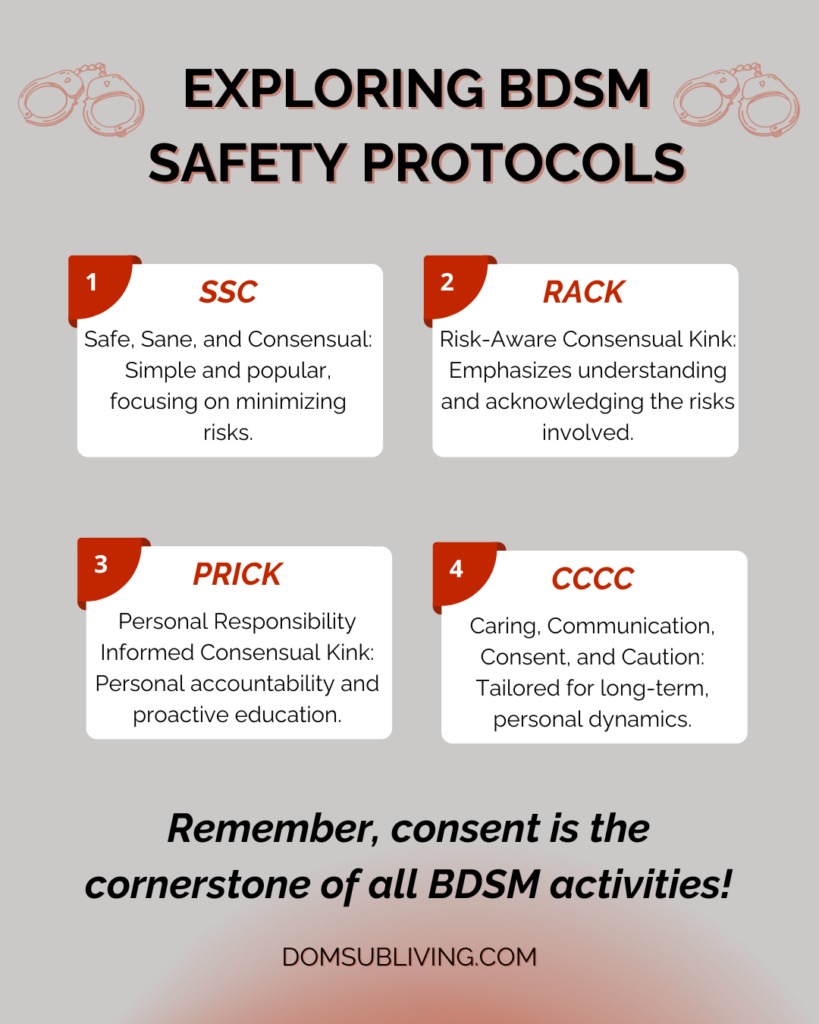SSC vs. RACK vs. PRICK: Which BDSM Safety Protocol Fits You? (Ep. 33)

LISTEN TO THE EPISODE:
APPLE PODCASTS | SPOTIFY | AUDIBLE
Today, we’re diving deep into a topic that often stirs up quite a bit of conversation within the BDSM community: the dynamics of communication and consent, and the use of different acronyms like SSC, RACK, PRICK, and others. Let’s explore these kink terms, my personal preferences, and why I advocate for clearer communication in our community. I even have a free dictionary for you to download.
Key Takeaways
- Consent is Paramount: Regardless of the protocol you choose, ensuring all BDSM activities are consensual is crucial.
- Understand the Risks: RACK and PRICK emphasize the importance of being aware of and understanding the risks involved in BDSM.
- Choose What Fits: SSC, RACK, PRICK, and CCCC offer different approaches; pick the one that aligns best with your comfort level and relationship dynamics.
- Continuous Education: Always educate yourself and communicate openly with your partners to maintain a safe and consensual environment.
- Adaptability: There is no one-size-fits-all protocol; be flexible and willing to adapt to find what works best for you and your partners.
Choosing the Right BDSM Safety Protocol
Navigating the complex world of BDSM involves prioritizing safety and consent. This is where frameworks like SSC (Safe, Sane, and Consensual), RACK (Risk-Aware Consensual Kink), and PRICK (Personal Responsibility Informed Consensual Kink) come into play.
Each of these protocols offers a different approach to managing risk and ensuring consensual practices within BDSM. Let’s look at each of these protocols, examining their pros and cons, and help you determine which one fits best for you.

SSC: Safe, Sane, and Consensual
SSC is probably the most well-known framework within the BDSM community. It stands for Safe, Sane, and Consensual. Let’s break down what each of those mean:
- Safe: The idea here is to minimize risks involved in BDSM activities. However, it’s important to note that nothing in BDSM is entirely safe. Even basic practices like using handcuffs can pose risks like pinching nerves or cutting off circulation.
- Sane: All participants should be in a sound state of mind and able to distinguish between right and wrong. Some may argue that this term can be seen as ableist, implying that individuals with mental health issues shouldn’t engage in BDSM, which isn’t necessarily true. (You can learn more about my own mental health struggles here.)
- Consensual: All activities must be agreed upon by all parties involved.
Pros of SSC:
- Simplicity: It’s straightforward and easy to remember.
- Familiarity: It’s widely recognized and used within the BDSM community.
Cons of SSC:
- Safety Myth: It can be misleading since no activity is completely safe.
- Ableism Concerns: The term “sane” may unintentionally exclude those with mental health challenges.
- ‘Ethical’ Confusion: Adding “ethical” to SSC (making it SSCE) makes it more complex and can come across as judgmental.
RACK: Risk-Aware Consensual Kink
RACK shifts the focus to acknowledging and understanding the risks involved in BDSM activities. For this reason, you’ll often see RACK promoted at dungeons and clubs for liability protection. This protocol emphasizes informed consent where all parties are aware of the potential dangers involved in a scene.
Pros of RACK:
- Risk Awareness: It encourages participants to be knowledgeable about the risks, promoting informed decision-making.
- Realism: It acknowledges that BDSM can never be entirely safe, which is a more realistic approach.
Cons of RACK:
- Negative Connotation: The emphasis on “risk” can deter newcomers or those curious about BDSM by portraying it as inherently dangerous.
- Overkill for Beginners: For those new to BDSM, the focus on risk might be overwhelming and off-putting. For example, activities like kneeling or using a blindfold aren’t typically risky.
PRICK: Personal Responsibility Informed Consensual Kink
PRICK takes the principles of RACK a step further by emphasizing personal responsibility. It encourages individuals to take responsibility for their own safety and education regarding BDSM practices.
Pros of PRICK:
- Empowerment: It promotes personal accountability and encourages participants to be proactive about their safety and consent.
- Informed Consent: Stresses the importance of being well-informed about BDSM activities.
Cons of PRICK:
- Complexity: The term is a mouthful and can be hard to remember and explain.
- Potential for Victim Blaming: Emphasizing personal responsibility might lead to victim-blaming in cases when things go wrong during a scene.
- Shifting Responsibility: It might place too much responsibility on subs, letting fake doms avoid their duty of care.
CCCC: Caring, Communication, Consent, and Caution
CCCC (or the 4 C’s) is a newer framework that focuses on long-term, 24/7 dynamics or loving Master/slave relationships. It emphasizes a holistic approach to BDSM relationships.
Pros of CCCC:
- Holistic Approach: It incorporates emotional aspects, making it suitable for more personal and long-term dynamics.
- Comprehensive: It covers multiple aspects of BDSM relationships, including care and communication.

Cons of CCCC:
- Complexity: It’s a lot to remember and can be overwhelming, especially for beginners.
- Not Universally Applicable: The emphasis on care may not fit all BDSM dynamics, particularly those involving degradation or objectification.
A New Approach and What I Personally Use
Given the limitations of SSC, RACK, and PRICK, I’ve been using a simpler, more universal concept: Consensual. In fact, here at Dom Sub Living, one of our Core Values is, “Consent is sacred.” (You can read our other Core Values here.) This approach focuses on making sure all BDSM activities are consensual without adding on extra rules.
Pros of the Consensual Approach:
- Simplicity: Easy to understand and remember.
- Focus on Core Principle: It highlights the most crucial aspect of BDSM—consent.
Cons of the Consensual Approach:
- Lacks Specificity: It may not address specific safety or risk considerations that other frameworks highlight.
FAQs About SSC, RACK, and PRICK in BDSM
What is the difference between SSC, RACK, and PRICK in BDSM?
SSC (Safe, Sane, and Consensual) aims to minimize risks and ensure all activities are safe and consensual. RACK (Risk-Aware Consensual Kink) and PRICK (Personal Responsibility Informed Consensual Kink) focus on understanding risks and taking personal responsibility for safety and consent.
Why might someone prefer RACK over SSC in BDSM?
Someone might prefer RACK over SSC because it admits no BDSM activity is completely safe and highlights the need to understand the risks. This realistic view helps people make better decisions and engage in BDSM more safely.

How does the PRICK protocol enhance personal responsibility in BDSM?
The PRICK protocol encourages people to learn about BDSM practices and understand the risks. It promotes a culture where everyone is responsible for their safety and consent, creating a more informed and responsible BDSM community.
How can I decide which BDSM safety protocol (SSC, RACK, or PRICK) is best for me?
You should choose a safety protocol based on your comfort with risk and responsibility. SSC is simple and popular, RACK acknowledges risks, PRICK values personal accountability, and CCCC focuses on care and communication in long-term dynamics. Try each one and see what you’re comfortable with.
Conclusion
Choosing the right safety protocol in BDSM depends on your preferences, experiences, and relationship dynamics. SSC, RACK, PRICK, and CCCC each offer valuable ways to manage risk and ensure consent.
The key takeaway is that consent should always be a top priority in any BDSM activity. Whether you like the simplicity of SSC, the realistic approach of RACK, the personal accountability of PRICK, or the care and communication of CCCC, what matters most is that everyone feels informed, respected, and consensual.
For beginners or those wanting a simple approach, “Consensual” can provide the needed clarity and focus, ensuring all activities are consensual and communication stays open and honest.
Remember, no single framework fits everyone perfectly. Find what works best for you and your partners, keep educating yourself, and maintain open dialogue to ensure everyone’s safety and satisfaction.
Links From the Episode:
Want more? Sign up for my newsletter and get BDSM tips on the regular.



